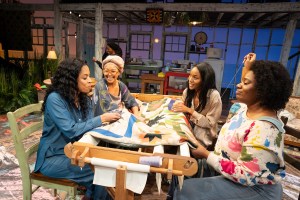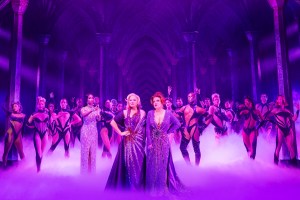
Carol Channing’s new autobiography, Just Lucky I Guess (Simon & Schuster 262 pages, $24.95) is subtitled “a memoir of sorts,” and that’s truth in advertising. It’s hardly a blow-by-blow, and-then-I-starred-in, chronologically conventional reminiscence. Large swatches of both Channing’s private and public lives are absent, and trying to follow her logic is often like chasing a pinball (as she’d be the first to admit). But that’s our Carol, and if what she omitted is missed, what she included is often riveting.
It takes barely half a page to convince the reader that, yes, this is Carol’s own voice; no ghostwriter could possibly capture it as well. “I have been prostituting myself all of my life,” she startlingly announces in about the third sentence. “I’ve been making love to an audience since the fourth grade. It’s interesting to me that what I do onstage is legal, whereas what’s done in bed is not. That’s odd, don’t you think?” From there on, the tone is casual and conversational, even hectoring, as Channing seems to beg for validation from the reader every time she states an opinion.
And her opinions are many — about people, about performing, about the healing powers of creativity. (A lifelong and devout Christian Scientist, she keeps coming up with examples of friends and acquaintances whose illnesses were overcome by simple, concentrated, purposeful activity.) The literary Carol is very like the Carol you’ve seen on talk shows or the one who gave a curtain speech every night during the last revival of Hello, Dolly! — smart but scattered, worldly yet ingenuous. Maybe you’ve wondered from time to time whether the Channing persona is all an act? Well, by book’s end, I was convinced it wasn’t. (If it is, it’s a hell of a performance.)
Channing’s is a peculiar career built mostly on two roles: Lorelei Lee in Gentlemen Prefer Blondes and Dolly Levi in Hello, Dolly! (It turns out, surprisingly, that these shows were not her favorites; Lend an Ear and the national tour of Sugar Babies were.) So it’s tempting to dismiss this performer as, well, Dolly-Lorelei. The only six-foot-tall, blonde, bass-baritone woman in show business, she’s instantly recognizable, easily parodied, and — at least in some circles — appreciated more for her strangeness than her artistry. But artistry she has, and intelligence. If you’ve ever heard her discuss acting, you already know that; if you haven’t, here’s your chance to find out.
Born in Seattle in 1921 to theater-loving parents (her father was a journalist and lecturer, her mother a beauty who lived to be 100), Carol writes of a largely idyllic only-childhood. She and her father adored each other, there was (and still is) her loyal Cousin Dickie for peer companionship, and the instantly stage-struck young girl encountered little of the conventional heartbreak on the road to stardom. A gift for mimicry, discovered at an early age, made her popular with classmates and earned her the vice-presidency in high school. (The president was George Fennemann, later of “You Bet Your Life.”) She had a mostly marvelous time as an arts major at Bennington, auditioned for and won the comic lead in Marc Blitzstein’s agitprop Broadway opera No For an Answer, moved back west, joined the smart revue Lend an Ear (directed by Gower Champion), took the show to New York, became Broadway’s toast of 1948 — and was spotted by Anita Loos, who announced, “There’s my Lorelei!” (Gentlemen Prefer Blondes was just then casting.) Not a lot of drama in any of that, is there?
Well, no. But Channing conveys it all with a warmth, intimacy, and hilarity that make the reader feel as if he’s her honored backstage guest. Like most performers of her generation, she treats her public with an almost reverential respect and gratitude; and her unfiltered, stream-of-consciousness reminiscences, while sometimes hard to navigate, seldom fail to ingratiate. “We must stop here for the sake of clarity,” she writes early on, “which I need not tell you is not my forte.” But some juicy show biz story is likely to follow, or a theatrical memory so vivid — like that of Ethel Waters in As Thousands Cheer, for instance — that Channing can recall the set, the costume, and the staging.
She has been fortunate to have worked with or been associated with most of the great entertainers of the 20th century, and a goodly number of them parade through the book: Al Jolson, Jimmy Durante, George Burns, Yul Brynner, Loretta Young, Tallulah Bankhead, Noel Coward, Elizabeth Taylor, and Marlene Dietrich, to name but a few. Of Barbra Streisand, Channing says: “She came backstage after the Actors’ Fund performance of Dolly and it began a beautiful friendship. When she got the movie of Dolly, that was the end of that.” (Even more telling is a hilarious, 1964 photo, wherein Channing is turning on the charm for President and Mrs. Johnson while Streisand is caught awkwardly at the side, cleaning her fingernails.) A long chapter on the Kennedys recreates a heavenly White House dinner of 1962 during which JFK tries to explain the space program to Channing while Teddy croons Irish ballads.

Other highlights are funny and touching chapters on Ethel Merman and Mary Martin, both of whom Channing worked with late in their careers, and a nail-biting account of a nerve-wracking weekend spent with Alfred Lunt and Lynn Fontanne at the home of John Wilson. (Channing had been dispatched by the cash-strapped producers of Gentlemen Prefer Blondes to entice the couple to invest; rather than having her audition in conventional fashion, Lunt and Fontanne interviewed Channing at length in the library about Lorelei Lee. By the end of the visit, she had their check.) Throughout, she’s loving and complimentary, even to the alleged ogres of the profession: Richard Rodgers was a “lovely man,” Gower Champion a “benevolent dictator,” David Merrick “extremely attractive. He could give you a sudden, sophisticated, confidential warmth.” So when the claws come out, for unflattering portraits of Lady Astor and Leona Helmsley, you have to believe that those people are real horrors.
This largely fond, circumspect quality extends to the important people in Channing’s private life. Her first husband, Ted Naidish, was a struggling writer with a large Russian-Jewish family whom Carol adored. Her second, Alexander Carson, was a center for the Ottawa Rough Riders and father of her beloved only son, Chan, now a well-respected political cartoonist. Judging from her sympathetic accounts, both marriages appear to have been happy but imperfect, and brief; the third, to manager-publicist Charles Lowe, lasted 42 years. When Channing served divorce papers to the ailing Lowe a few years
ago, ugly details poured forth and gossip columnists had the sort of nasty field day they usually reserve for younger celebrities. Yet Channing is polite and detached when mentioning Lowe, only hinting at a greater unhappiness.
Fans of you-are-there show biz history will find much to savor here, too. We watch Gower Champion stage the “Hello, Dolly!” number step by step while Jerry Herman’s score gets rewritten and out-of-town pressures mount. (Dolly! went into Detroit as A Damned Exasperating Woman and it was conceived as an intimate, no-razzle-dazzle affair.) We sweat between takes of The First Traveling Saleslady, the film that brought down RKO, wherein a young Channing was paired with… Clint Eastwood. And we suffer the out-of-town indignities of The Vamp, Channing’s first star vehicle and a legendary flop. (“The main thing I learned from this experience was: If there is no ‘benevolent despot’ at the head, then the book writer thinks the show is about his plot, the choreographer thinks it’s about the dances, the composer, about the music…And I’m sure I thought it was about something nobody else thought of.”)
So the sins of omission are pretty curious. If Channing can run on about The Vamp for several pages, why not even a mention of the movie Skidoo, an Otto Preminger disaster that co-starred Channing and Jackie Gleason? She repeatedly mentions touring in Wonderful Town but there’s no account of how it was received or how her Ruth Sherwood differed from Rosalind Russell’s (considerably, one would surmise). And where’s Yvonne Adair, Channing’s co-star in both Lend an
Ear and Gentlemen Prefer Blondes? Channing’s memory is decidedly selective.
It’s also questionable in terms of timing. Channing has 20th Century-Fox buying Marilyn Monroe a ticket to Blondes every night for a month to study Channing’s performance; but this would have to have been in 1950 or ’51, and Monroe wasn’t yet a star. When the Blondes movie does open, in 1953, Channing supposedly is already touring in Wonderful Town — which sounds unlikely, since the show premiered on Broadway in February of that year and ran 17 months. And while Channing and Mary Martin are rehearsing Legends (1985), Carol regales Mary with anecdotes about Zoe Caldwell in Master Class (1994)! All of this is not to question Channing’s veracity or to pelt her with “gotchas,” merely to suggest that some of the particulars of her very engaging stories may be misremembered.
But then, what do you want: a bloodless fact book, or a seat at the table as Channing throws a dinner party for Lunt, Fontanne, Burns, and Allen? (The two couples had formed a mutual admiration society for decades, but this was their first face-to-face meeting.) Accurate dates and figures, or to chance to stand within earshot of Channing, Merman, and Ann Miller as they film The Love Boat? (Miller and The Merm are outrageously bawdy, and they keep crowding Channing out of the shot.) A straightforward, chronological summation of a career, or a seat in the limo while Channing and Bea Lillie are filming Thoroughly Modern Millie?
Channing’s career may have lacked the high drama of, say, Maria Callas’s, or the breadth and virtuosity of Katharine Hepburn’s. All the same, she created two indelible icons of 20th-century popular entertainment and, in doing so, managed to remain within the orbit of most of the fascinating political and entertainment figures of the day. When Gentlemen Prefer Blondes was revamped as Lorelei in 1974, the now-top-billed Channing was awarded a new opening number that began: “It’s nice looking back, looking back on the past / When you’ve a past full of memories that last.” Amen to that, Ms. Channing, and thanks for the memories.









